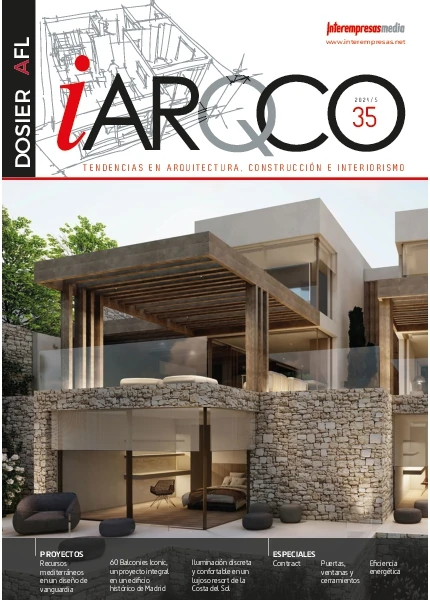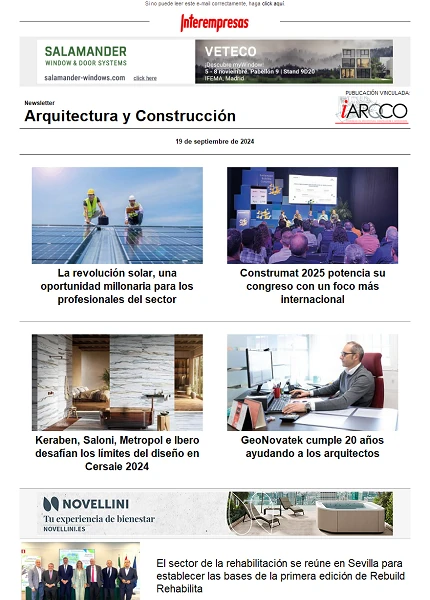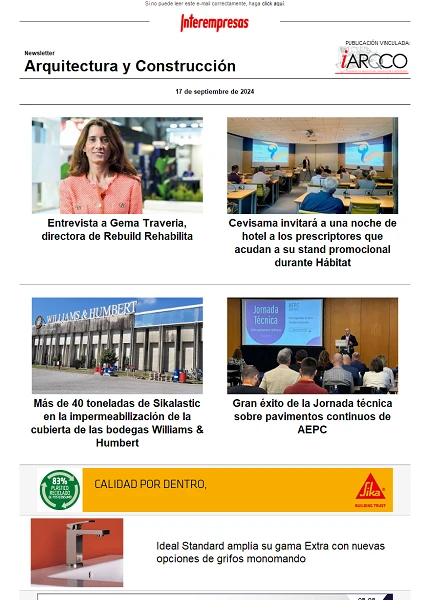Inbeca Deepens in the history and in the advantages of the Finnish sauna
1 February 2012

In Finland there is 5,1 million inhabitants and 1,7 million saunas, one each three people. The sauna is considered a typically Finnish phenomenon, although it is not an invention neither a private property of the Finns. To ends of the 19th century in the Old Continent the habit existed in all a region that extended from the Báltico until the heart of the mountains Urales. The sauna also is generalised amongst other villages ugrofineses of the region of the Báltico (estonios, carelianos, vepsos and livones) as well as between several Slavic villages, bálticos (Latvian and Lithuanians), tartars of Turkey and ugrofineses oriental.
The traditional Finnish sauna is a wooden chamber, where the bañistas seated in terracings launch water on hot stones situated on a stove.
Sauna is the Finnish word internationally more spread, although according to the Finns no always has conserved his original meaning when being adopted by other tongues. The expressesion “take a sauna” does not mean only go in in the enclosure caldeado but all a rite composed by several lapses of transpiration to the heat of the stove and of the steam of the water that launches on the stones. This steam (löyly) is precisely the spirit of the sauna. Löyly Is a word ugrofinesa that is in our vocabulary from 7.000 years ago.
This type of bathroom is not exclusive of the Finns. In many other cultures exist constructions and similar habits (the roman bathrooms, Turkish, celtic, the sweat lodge of the North American Indians, the furo of the Japanese, the bania of the Russians and the temascal Mexican). But the Finns can be considered the village “saunero” by antonomasia because they have kept live the tradition and have adapted it to his contemporary way of life. They have conserved, developed and transmitted the sauna, and have spread it internationally low labels it ‘Finnish sauna'.
Brief history of the Finnish sauna
The word sauna already was in the lexicon of the ancient suomi (fineses) and sami (lapones). The core of the sauna consisted in a stove that heated a battery of stones, around which took a bathroom of steam under an occasional cover like the ones of the sudaderos of the North American Indians. It is possible that already there were bathrooms of transpiration like the sauna in the age of stone, does some 6.000 years: the fogones of the houses were some hoyos circular no very deep in whose basic there was two or three layers of small stones.
There are evidences that between the 5th and 8th centuries already knew in Finland the wooden saunas. They were cabins of trunks, of an alone chamber, that heated by inside by means of fire and smoke (sauna of smoke). At the beginning the sauna took in the only chamber of the house. The Finnish technology of construction with trunks has been carried by the emigrants to all parts in the course of the millenniums. In the New World can see in the structure of Pioneer House, in New England.
The original Finnish sauna
The stove of smoke was a coarse vault of stones with the fire inside and a cúpula rounded on which had the stones. It was the fogón of the house and followed using in the saunas of smoke that served to heat the house and the sauna, but no to cook and hornear, by what in the 11th century began to use an oven with a camera closed up and a place advance to heat containers. Of this way developed two fogones different, one adapted for the house and the another for the sauna, the one who went little by little independizándose in his function of chamber of bathroom, although keeping his condition of field of several domestic tasks.
To ends of the 18th century in the west saunas of Finland began to appear enclosed stoves of brick, safer that the open that constituted a permanent danger of fires. The new stoves had two or three cameras: down the fogón, in the half the stones, and in the one of up produced the smoke that filled the chamber.
The sauna obtains his chimney
The stove with chimney constituted, to ends of the 18th century, a big development in the history of the sauna. To the oven of enclosed smoke added him a simple cannon, a narrow continuation of the upper camera, or was a true chimney with his register of shot that drove until the outside of the roof. In the 19th century generalised a chimney amurada, with own base, at the side of a separate stove of brick.
The stove with exit of smoke made possible the construction of saunas in places where the sauna of smoke was unthinkable, for example in the cities, that had mainly wooden houses with favourable gardens to install the box.
To 1910 began the production in series of stoves with carcasas metallic. The manufacturers excited with the business and were perfecting the models, until in the years thirty appears a totally new type, the stove of continuous heating, in which the leños burn in his own separate camera and neither the flames neither the smoke go in in contact with the stones, like sucedía in the stove “of hornadas”. The novelty allows to keep the fire going lit during the bathroom and produce steam while there is firewood.
The urban Finnish sauna
The new models of stove promoted in the years thirty a renaissance of the Finnish tradition of the sauna, that had waned in the first decades of the century with the problems of the process of urbanisation of the agricultural society that cultivated it.
The urbanisation of the society began to strengthen from the decade of 1880, with the gradual construction of the systems of common waters and of cloacas, the electrificación and the edificación of houses of mampostería and buildings of flats. The chamber of bathroom and the big novelty that brought the century, the bath, offered to the Finn destellos of a European luxury that did to resemble the sauna an old-fashioned and rural habit. At least the inhabitants of the buildings of apartments had remained decades without sauna if there had not been public bathrooms.
The public saunas had separate sections for men and women and even sectors reserved, where the families could hire his own turns. The big establishments of bathrooms offered to his customers services of washing machinees, masajistas and sometimes of application of suckers. Like the parroquianos concurrían regularly to the same sauna, there formed groups in a friendly environingingment, without more hierarchies neither titles that the livestocks from time to time by the resistance to the high temperatures. The public saunas constituted a historical stage, special in many respects, that lasted until the fifty. When finalising the second world-wide war worked in Helsinki almost ciento fifty public saunas, but when beginning the 21st century remained only two.
The electrical stove is safe and easy to use, as it bases in a resistance that lights with a simple switch and heats the stones to the temperature wished.
As it does not need pipe for smoke, can install in places in which it would be impossible to put an oven of firewood. The sauna no longer requires an isolated construction, and can emplazarse in any house like a room more.
The electrical stove solved definitively the problem of the urban saunas. From the years fifty in the low plant of the buildings of flats began to build on time the sauna of the condominium for which each family has a weekly turn. In the actuality instead of a common sauna, in each apartment is used to build beside the chamber of bathroom an own sauna, a speciality of the Finnish urban house. Also they have begun to install small saunas of the same type in the chambers of hotel... A very Finnish contribution to the world-wide hospitality industry!
• Nervous Distention. Relaxation.
• Dilatation respiratory ramifications. Oxigenación.
• Glass peripheral dilatation. Stimulation of the blood circulation in extremities.
• Elevation of the cardiac frequency. It stimulates the circulatory system.
• Cleaning of toxins of the pores. Glands sudoríparas.
• Improves of the elasticity of the muscular fabric and osseous articulations.
Caldeamiento Of the sauna and ancient habits
In the past the sauna was a holy place for the Finns. It was in the playground of the house, until at the beginning of the 20th century began to build to banks of the lakes, following the example of the elegant mansions. It was used to take the sauna once a week, as the caldeamiento of the enclosure for several turns, especially in the saunas of smoke, could carry all a day. The election, placing and addition of the leños was all an art, but the fundamental was to keep the sober spirit; the experts in caldear the sauna and make do them of branches of birch knew to work without hastes, and trasmitían his technicians of generation in generation.
The session of sauna has a lot of traditional norms. According to the saying «the sauna, like the church requires recogimiento». All the world knows that in the sauna is forbidden to disturb, say groserías, chismorrear, speak badly of the prójimo, pedorrear or do noise. To the boys teachs them the label of the sauna, with his norms and prohibitions.
The ancient Finnish tradition indicates congruentemente that the image promiscua vulgarmente associated to the culture of the Finnish sauna, is inaccurate. Men and women had in the agricultural community his own turns, and until the sauna in family is a back phenomenon. In the past the pattern went in first to the sauna with the labourers, after the labranza, and afterwards the lady with the servants when going back of the milking.
The Finnish literature is full of substantial scenes of sauna, the most famous of them in The seven brothers of Aleksis Kivi: the protagonists take his sauna of Navidad tumbados on montones of straw in his new ranch caldeado by the smoke, taking a special beer... And the sauna sets fire ! The literature is used to to take advantage of the rich popular tradition.
The sauna is very linked to the agricultural calendar, as in her realised a lot of important works: espadillaba the linen, cured the meat, ahumaban the fiambres, desecaban and azucaraban the malts, put to germinate the popes of seed and washed the clothes. These seasonal works, that gathered during several days to the youngsters and the elderly of the family, were accompanied by poems and popular songs: to the rhythm of the work sang (until coplas eróticas), related histories, explained tales and resolved riddles.
In the calendar folclórico there were special days in which they did presagios for the coming year, for the agriculture, the future weddings... In Koivisto, in the isthmus of Carelia, the day before of new year in all the houses heated the very early sauna before rayar the alba. It ensured that “the works will do to time all the year and at all will retard if the first day of the year the steam goes up to the skies before that the sun”.
The pleasures of the sauna
Why the Finns take his sauna? Because it is an ancient tradition and are accustomed from boys. The clean sauna and offers health, spiritual peace, vivencias and a lot of other pleasures.
...Cleaning. In the past the sauna offered the possibility of a deep cleaning at least once a week. At present the modern sanitary ware of the houses replace to the sauna in this his elementary function, but this follows considering an indispensable element of the houses. A good transpiration in the sauna, followed of an enjuague, clean the leather much better of what supposes .
...Health. The old Finnish saying "if it does not cure with sauna, aguardiente and alquitrán, the bad is mortal" it does not mean at all that these three effective “remedies” have to administer at the same time. The people attends to the sauna when it feels need to give back to his normal state a tired body or some sore muscles by the hard work.
...Spiritual peace. F. And. Sillanpää, our Nobel prize of literature, explained that after a long period of production had gone back, fatigado and knocked down, to rest with his parents in his natal house. The same night of his arrival, in the warm and silent penumbra of the sauna, felt that they went banishing little by little his anxiety and his depressesion. After the bathroom, recovered the sosiego and full of power creator, felt smart to return immediately to his cuartillas.
The sauna relaxles, calm and gives back the spiritual peace. Many times in the middle of taut negotiations the parts have shared a sauna, to distend and arrive afterwards to unanimous and profitable agreements.
...vivencias. To these people atareada, forced to squeeze each minute, the peace of the sauna attains to detain them in the time. If something measures the internal clock, is only the ideal length of the session of sauna. The sauna offers plácidas vivencias that experience with all the senses.
After a sauna do not exist hastes. The mind and the humour elevate above the duties and daily worries, the body seems desentumecido, the muscles relaxed and the easiest life.
The healthy effects of the sauna
Antaño The people for sanarse went to the sauna. In her the shamans could concentrate in peace in his science, and the spirit of the patients also was favourable to cure , since the sauna was linked to a lot of beliefs and to one some solemnity. The faith in the powers curativos of the sauna still has not extinguished ; although it knows that by himself alone does not cure neither warns the chronic ailments, promotes the general welfare and has beneficial effects on the health, even on the symptoms of some illnesses. In the sauna accelerate the pulse, the breath and the circulation, increases the corporal temperature, activates the metabolism and the arterial pressesure can descend transitoriamente.
The medicine has a lot of respect by the effects of the sauna. This strengthens the body and sosiega the spirit. The handle of the sauna was a special art of the curanderos, the experts in suckers, sangradores and ensalmadores fine-carelianos.
In what base the properties curativas of the sauna? It says the tradition chamanística that “...In the sauna will soften you. When you feel that they hurt you the veins and the bones tighten you, the remedy is a sauna. When you have jaquecas, have to go to the sauna. When you have cough will not be able to go until it have happened you . If you go in in the sauna aterido of cold, this will take refuge in your heart. First you will have to heat you by inside and only afterwards take the sauna".
The always present sauna in the life
The sauna is from always a holy place for the Finns, to where go to purifitruckse the body but first of all the spirit. In the past it was stage of a lot of crucial moments of the life, from the childbirth until the wash of the corpse. All these rites that were without exception oficiados by the women of the house. Only in critical situations -for example when a recently cream or a patient were very ill- requested the help of a witch, a hechicero or a curandero. They were extreme cases, in which it attended to the highest spiritual authority of the place or of the family, a woman or a man that reestablished order of the community with his arts curativas.
Until the second war, the Finnish woman by general rule gave to light in the sauna. It has to remember that this was a clean and warm enclosure, the most hygienic of the rural habitat. The “days of sauna” that preceded and followed to the childbirth and conserved until principles of the 20th century, were reserved to the women. They could last a week until the beverages was solemnly carried to the choza. According to the ancient popular tradition, only then the father could see to his son. In accordance with a habit that imperaba in the Nordic countries in periods precristianas, the boys purchased his name when the most elderly man of the family poured water on his head. The ceremony was afterwards replaced by the baptism.
The deep meaning of the sauna
The sauna is part of the Finnish identity, a national institution that has arrived live to the 21st century. It allows us analyse our own traditions, and his comparison with the bathrooms and the ablutions of other villages offers us a perspective to appreciate the habits and the idiosyncrasy of other cultures. Observing to the prójimo learn to know us more deeply to us same. The inapi in the choza to sweat of the North American aborigines, the furo of the Japanese and the sauna of the Finns have, in spite of his differences, a lot in common, especially to spiritual level. Transpirar In the steam of the sauna or of the sweat lodge, or in the hot bathroom of the furo, is much more that a cleaning of the body; it is a rite that relaxles the body and the spirit. The key is the re-creation that produces in a spirit stimulated by the steam or the bathroom.
The beneficial therapeutic effect of the Finnish sauna is not immediate, thus the sessions have to realise of regular form.
• Shower of hot water. Start of the opening process pore.
• Dry properly all the body.
• Gone in in the cabin. It is not correct to go out of the same before feeling the need, but neither is it remain in her feeling this need.
• Gone out of the sauna. Shower of cold water, beginning to rociarse by the extremities.
• Initiate phase 3. Phase of repetition.
• Phase of rest. This phase is important since it complements the process of relaxation.
• Shower again with temperate water, to delete all the sweat.
• If it wishes it can ingerir water.




































































































